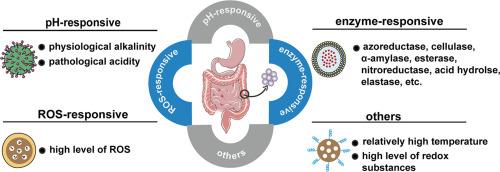用于炎症性肠病治疗的刺激响应性纳米给药平台
IF 9.4
1区 医学
Q1 ENGINEERING, BIOMEDICAL
引用次数: 0
摘要
炎症性肠病(IBD)表现为结肠、直肠和回肠的炎症,是一个全球性的健康问题,发病率越来越高。因此,有效的抗炎疗法是预防和治疗 IBD 的有效策略。然而,治疗 IBD 的传统纳米给药系统(NDDSs)在靶向肠道方面面临许多挑战,如生理和病理障碍、基因变异、疾病严重程度和营养状况等,这往往会导致非特异性组织分布和药物释放失控。为了解决这些局限性,刺激响应型 NDDS 因其在提供控制释放和增强靶向性方面的优势,近年来受到了广泛关注。本综述概述了 IBD 的病理生理机制,并总结了用于 IBD 治疗的微环境刺激响应型纳米载体的最新进展。这些载体利用 pH 值、活性氧、酶和氧化还原物质等物理化学刺激来递送治疗 IBD 的药物。此外,还强调了刺激响应型 NDDSs 在未来开发和临床转化中面临的关键挑战。本综述深入探讨了刺激响应型给药纳米平台的开发和优化,旨在促进其在 IBD 治疗中的应用。意义说明:本综述重点介绍了用于治疗炎症性肠病(IBD)的刺激响应型纳米给药系统(NDDSs)的最新进展。这些创新型纳米平台可对特定的环境触发因素(如 pH 活性氧、酶和氧化还原物质)做出反应,直接在炎症部位释放药物。通过总结最新研究,我们的工作强调了这些技术在改善药物靶向性和疗效方面的潜力,为 IBD 治疗提供了新方向。这篇综述意义重大,它为研究人员和临床医生提供了一个全面的概述,有助于开发更有效的治疗方法来治疗 IBD 和其他慢性炎症性疾病。本文章由计算机程序翻译,如有差异,请以英文原文为准。

Stimulus-responsive drug delivery nanoplatforms for inflammatory bowel disease therapy
Inflammatory bowel disease (IBD) manifests as inflammation in the colon, rectum, and ileum, presenting a global health concern with increasing prevalence. Therefore, effective anti-inflammatory therapy stands as a promising strategy for the prevention and management of IBD. However, conventional nano drug delivery systems (NDDSs) for IBD face many challenges in targeting the intestine, such as physiological and pathological barriers, genetic variants, disease severity, and nutritional status, which often result in nonspecific tissue distribution and uncontrolled drug release. To address these limitations, stimulus-responsive NDDSs have received considerable attention in recent years due to their advantages in providing controlled release and enhanced targeting. This review provides an overview of the pathophysiological mechanisms underlying IBD and summarizes recent advancements in microenvironmental stimulus-responsive nanocarriers for IBD therapy. These carriers utilize physicochemical stimuli such as pH, reactive oxygen species, enzymes, and redox substances to deliver drugs for IBD treatment. Additionally, pivotal challenges in the future development and clinical translation of stimulus-responsive NDDSs are emphasized. By offering insights into the development and optimization of stimulus-responsive drug delivery nanoplatforms, this review aims to facilitate their application in treating IBD.
Statement of significance
This review highlights recent advancements in stimulus-responsive nano drug delivery systems (NDDSs) for the treatment of inflammatory bowel disease (IBD). These innovative nanoplatforms respond to specific environmental triggers, such as pH reactive oxygen species, enzymes, and redox substances, to release drugs directly at the inflammation site. By summarizing the latest research, our work underscores the potential of these technologies to improve drug targeting and efficacy, offering new directions for IBD therapy. This review is significant as it provides a comprehensive overview for researchers and clinicians, facilitating the development of more effective treatments for IBD and other chronic inflammatory diseases.
求助全文
通过发布文献求助,成功后即可免费获取论文全文。
去求助
来源期刊

Acta Biomaterialia
工程技术-材料科学:生物材料
CiteScore
16.80
自引率
3.10%
发文量
776
审稿时长
30 days
期刊介绍:
Acta Biomaterialia is a monthly peer-reviewed scientific journal published by Elsevier. The journal was established in January 2005. The editor-in-chief is W.R. Wagner (University of Pittsburgh). The journal covers research in biomaterials science, including the interrelationship of biomaterial structure and function from macroscale to nanoscale. Topical coverage includes biomedical and biocompatible materials.
 求助内容:
求助内容: 应助结果提醒方式:
应助结果提醒方式:


